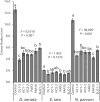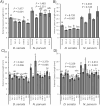Assessment of the potential of novel Californian grapevine Trichoderma isolates to reduce colonization of fungal trunk canker pathogens and Xylella fastidiosa
- PMID: 40995002
- PMCID: PMC12454315
- DOI: 10.3389/fpls.2025.1609693
Assessment of the potential of novel Californian grapevine Trichoderma isolates to reduce colonization of fungal trunk canker pathogens and Xylella fastidiosa
Abstract
Introduction: Grapevine fungal trunk diseases are cosmopolitan and act to reduce vineyard yields over time. Additionally, Pierce's disease, caused by Xylella fastidiosa, is a fatal disease of grapevines and a major threat wherever it is endemic. These grapevine diseases are generally managed via cultural practices and chemical applications. However, management can be costly due to labor costs or are becoming less effective due to pathogen resistance to pesticides. Thus, there is increasing interest in biological control agents to manage grapevine diseases. Therefore, novel isolates of Trichoderma species were collected from grapevine tissues in California with the intention that these would be likely to survive and thrive in the semi-arid and very hot climate present throughout much of the state.
Methods: Genetic analyses and morphology were utilized to identify Californian vineyard-acquired isolates to species or species complex, which yielded several different species: two isolates of Trichoderma harzianum, two isolates of Trichoderma capillare, and two putative novel Trichoderma species. These were examined for activity against fungal trunk pathogens Diplodia seriata, Eutypa lata, and Neofusicoccum parvum via co-plating and spent media assays. Follow-up greenhouse studies also assessed the ability of isolates to limit fungal pathogen canker development and Xylella fastidiosa success over six months. Lastly, field studies tested the ability to limit or remove fungal trunk pathogen colonization of pruned spurs by the Trichoderma isolates from this study and two isolates from another study, which were an isolate of Trichoderma asperellum and a member of the Trichoderma saturnisporopsis species complex.
Results and discussion: Results potentially yielded Trichoderma isolates with some ability to limit fungal pathogens in culture, greenhouse plants, and pruned spurs in the field, and with the ability to be re-isolated after a full field season. However, these isolates were not able to consistently limit Xylella fastidiosa titers or Pierce's disease symptoms. Taken together, these experiments demonstrated the ability of California Trichoderma isolates to be deployed as locally sourced biological control agents to protect Californian vineyards as well as those in similar climates.
Keywords: Bot canker; Pierce’s disease; biological control agents; dieback; fungal trunk disease.
Copyright © 2025 Wallis, Shinde, Ellis, Gorman and Mekdara.
Conflict of interest statement
The authors declare that the research was conducted in the absence of any commercial or financial relationships that could be construed as a potential conflict of interest. The author(s) declared that they were an editorial board member of Frontiers, at the time of submission. This had no impact on the peer review process and the final decision.
Figures






References
-
- Antrim E., Ellis M. L., Wallis C. M. (2025). Evaluating the ability of Californian grapevine-isolated Trichoderma saturnisporopsis strain RSI and Trichoderma asperellum strain TLI to reduce fungal trunk diseases. PhytoFrontiers. doi: 10.1094/PHYTOFR-04-25-0034-SC - DOI
-
- Baumgartner K., Hillis V., Lubell M., Norton M., Kaplan J. (2019). Managing grapevine trunk diseases in California’s Southern San Joaquin valley. Am. J. Enol. Vitic. 70, 267–276. doi: 10.5344/ajev.2019.18075 - DOI
LinkOut - more resources
Full Text Sources

